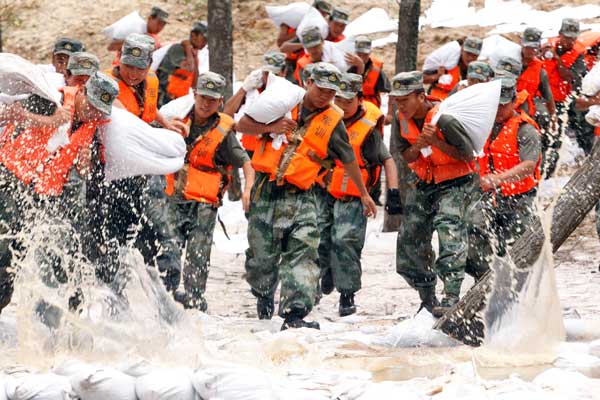Beijing, Moscow cooperate on floods
Updated: 2013-08-19 00:55
By Wang Zhenghua (China Daily)
|
||||||||
Central government praises Russia for reducing pressure on river
China and Russia are working well together to fight flooding that is affecting both countries, the central government said on Sunday.
Meanwhile, meteorologists warn that disaster control in Northeast China will be difficult in the coming week even though the heavy rainfall is expected to taper off.
 |
|
After more than five hours of work, soldiers successfully repaired a 1,000-meter dike that was on the verge of being breached in Xunke county, Heilongjiang province, on Saturday. The Heilong River's level in the county exceeded the danger mark by 1.76 meters on Saturday, causing the dike to spring several leaks. [Wei Jianshun / for China Daily] |
Beginning last week, continuous strong rainfall has caused the biggest flooding since 1998 in the provinces of Heilongjiang, Jilin and Liaoning. Swollen rivers have claimed at least 40 lives, with dozens missing and millions of other residents also affected by the disaster.
Some have said that Russia's discharge of floodwaters from upstream reservoirs made controlling flooding in China more difficult, especially in Heilongjiang.
But the Office of State Flood Control and Drought Relief Headquarters said on Sunday that Russia has paid close attention to the situation and worked with China on flood control efforts in the province.
"When flooding hit its Zeya and Bureya rivers, (Russia) made a strong effort to hold the flooding in its reservoirs, greatly reducing the flood pressure on the main stream of the Heilong River," the office said.
For instance, on Aug 2, the Zeya Reservoir saw a maximum inflow of water at 11,700 cubic meters per second but kept the outflow at 3,500 cu m per second.
At Bureya Reservoir, the water inflow reached 5,050 cu m per second on Friday, but Russia kept its outflow at around 1,000 cu m per second.
The remarks came after news reports that said China and Russia had accused each other of floodwater discharges that had worsened the flooding in the countries.
Meanwhile, meteorologists at the National Meteorological center said the rainfall, which has been strong since earlier this month, will lessen in the coming week.
From Monday to Thursday, Northeast China will see light to moderate rain, while eastern parts of Heilongjiang and the Inner Mongolia autonomous region will see heavy rain.
Even so, Heilongjiang, Jilin and Liaoning are gearing up for even worse flooding.
Among the big rivers in Heilongjiang, only the Wusuli River has had its water level below the danger level, said Hou Baijun, deputy director of the provincial flood control and drought relief headquarters.
All other rivers have reported their biggest floods since 1998.
According to the provincial civil affairs department, the disaster has killed 11 people, destroyed 1.44 million hectares of crops, flattened 2,560 houses and affected nearly 2 million residents since Aug 10.
Direct economic losses stood at 7.1 billion yuan ($1.16 billion), the department said.
In nearby Jilin, at least 14 people have died in the disaster. The flood also cut off roads, damaged reservoir, and forced dozens of businesses to suspend production.
In Liaoning, 15 flood-related deaths were reported in Fushun on Sunday, and 32 people disappeared after a torrential rain hit the region on Friday. More than 300,000 people in the city were affected by the disaster.
"The water rose so fast that people couldn't prepare for it," said Chu Yongge, a native of Fushun's Qingyuan county. "At my courtyard, the flood rose to about 2 meters within minutes on Friday night."
Hundreds were stranded on their rooftops for hours before emergency workers moved them to safe areas, he added.
In addition to regional governments that delivered relief supplies, China's central authorities on Saturday sent relief supplies to flood-hit areas in the northeastern region.
The National Commission for Disaster Reduction and the Ministry of Civil Affairs issued a Level IV emergency disaster relief response at 5 pm on Saturday, with a special work team sent to the region to guide local relief efforts.
A total 3,000 tents, 5,000 cotton quilts, 2,000 folding beds and 3,000 sleeping bags were delivered to disaster victims.
Zhou Huiying in Harbin contributed to this story.
Most Viewed
Editor's Picks

|

|

|

|

|

|
Today's Top News
Western program new engine for growth
China, Kenya agree to bolster ties
Online shopping clicking up
Typhoon wreaks havoc in the south
ROK-US drill starts as tensions ease with DPRK
Manners missing in overseas travel
Snowden reporter threaten UK
Egypt's Mubarak may be freed
US Weekly

|

|















